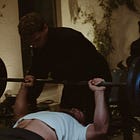Should Every Set Go to Near-Failure?
New study finds backing off can build the same muscle with less fatigue
Varying how close you get to failure in your training sets: will it boost muscle or strength, or just wear you out? This new study zeroes in on a major training dilemma for lifters—whether always pushing close to failure is necessary, or if backing off sometimes leads to equal gains but with less burnout.
Key Points
Aim
This research aimed to compare the effects of training with a fixed proximity-to-failure (always stopping at 1 rep in reserve, RIR1) versus varying proximity-to-failure (weekly progression from 4 RIR to 1 RIR, RIR1-4) on muscle growth, strength gains, session effort, and the accuracy of RIR estimation in resistance-trained individuals.
Methods
Participants: 31 resistance-trained young adults, randomised into RIR1 or RIR1-4 groups.
Duration: 10 weeks, split into two 5-week training blocks with similar programs except for RIR targets.
Testing: Squat & bench press 1RMs, vastus lateralis muscle cross-sectional area (CSA), triceps brachii thickness (TBT), RPE (session effort), and RIR estimation accuracy at start and end.
Exercise Program: Both groups followed identical upper-lower splits, with exercise volume, frequency, and progression closely monitored.
Results
Muscle Hypertrophy & Strength: Both approaches led to similar increases in muscle size (VL CSA: ~6.5% RIR1-4 vs. ~5.5% RIR1) and strength (bench press 1RM: ~7% RIR1-4 vs. ~9.6% RIR1; squat 1RM: ~9.8% RIR1-4 vs. ~9.2% RIR1).
Triceps Thickness: Only RIR1-4 saw a statistically significant triceps growth (5.8%).
Fatigue Perception: Session RPE scores were reliably lower in the varying RIR group (RIR1-4), indicating lower perceived exertion during training despite comparable volume loads.
RIR Accuracy: RIR estimation by trained individuals was already solid at baseline and further improved with RIR1-4 training, especially for estimating 3 RIR, not 1 RIR.
Practical Takeaways
Training always close to failure isn’t essential for muscle or strength gains if total volume is matched; cycling away then toward failure works just as well—even for trained lifters.
Backing off from failure at times (higher RIR) leads to lower fatigue and discomfort—lifters can recover better and possibly train harder or longer down the line.
Using RIR as a gauge is practical and effective; lifters can reliably self-regulate training without a coach or equipment, and their accuracy improves with practice.
For those struggling with motivation, burnout, or soreness, periodising proximity to failure may be a smart strategy.
No muscle or strength benefit was seen by pushing every set close to failure over 10 weeks.
Key Takeaways
Varying proximity-to-failure does not outperform fixed close-to-failure training for short-term size or strength improvements when volume is matched.
Lower RPE with varying RIR may help manage fatigue and sustain long-term progress.
RIR estimation is reliable and can be sharpened further within structured programs.
These results support flexible autoregulation for experienced lifters seeking progress without excessive fatigue or psychological drag.
Reference
Martikainen, O., Niiranen, H., Rytkönen, T., Schoenfeld, B. J., Ahtiainen, J. P., & Hulmi, J. J. (2025). Influence of Varying Proximity‑to‑Failure on Muscular Adaptations and Repetitions‑in‑Reserve Estimation Accuracy in Resistance‑Trained Individuals. Journal of Science in Sport and Exercise. https://doi.org/10.1007/s42978-025-00338-8
You can also find me at dannyleejames.com for stories, personal training insights, and coaching.









